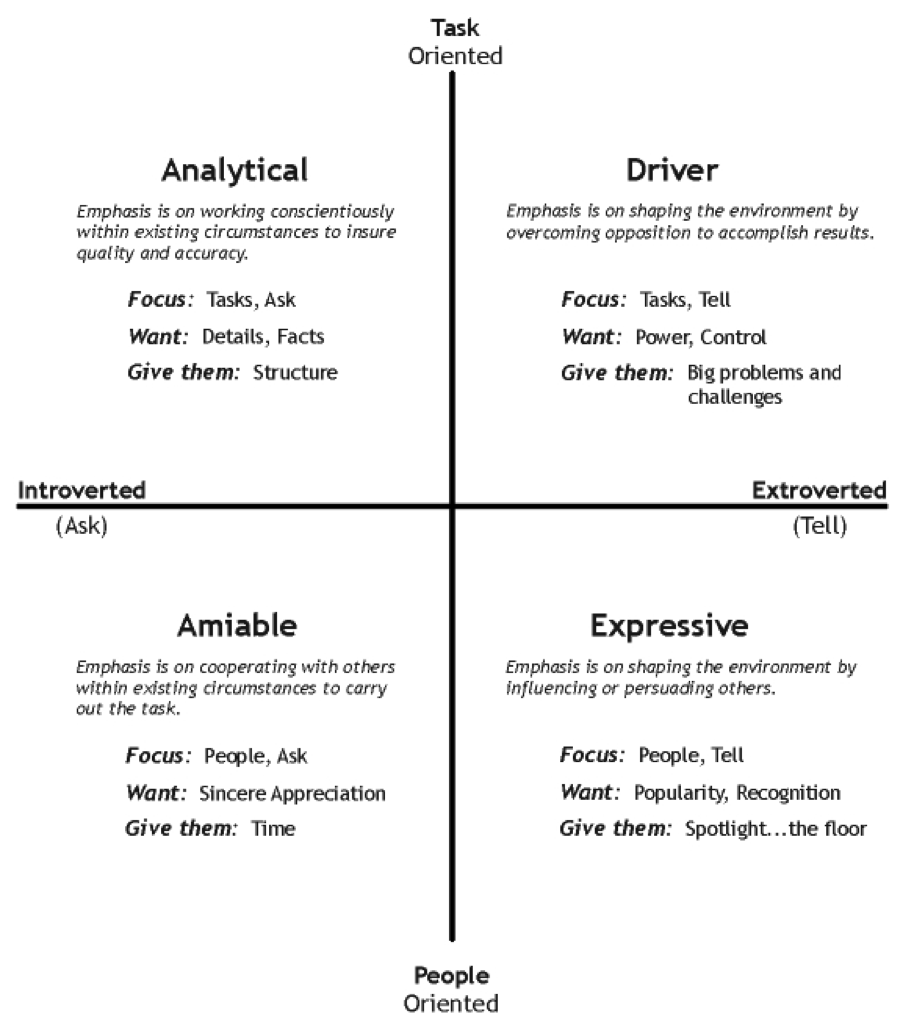A major aspect of emotional intelligence is the ability to build and manage your relationship and dynamic communication is an important component of relationship management. I recently had the opportunity to teach these skills to the members of the 2014 Opera America Leadership Intensive group.
One of their favorite communication tools was learning how to spot and use the 4 communication styles:
Driver: the person who likes to take control and be in charge
Analytical: the person who focuses on details and data
Expressive: the person who bubbles over with ideas and loves to have fun
Amiable: the person who cares about relationships
These 4 styles are aptly summarized in this chart:

The point of using communication styles is to be able to spot the style in others and to adopt your default to make sure that other people hear and understand your message, as well as influence others. The ability to use communication styles effectively is a powerful emotional intelligence skill. If you can adapt your style so that others will hear you, that will go a long way to contributing to a well-run team, as well as a successful outcome. As the Leadership Intensive participants found, this is a great way to push your leadership chops to the next level.
Here’s how:
ADAPTING TO THE DIRECTOR STYLE
- Messages should be short and to the point
- Use time efficiently and get to the point quickly
- Offer solutions and do not talk about process or methods
- Maintain a fast pace and be decisive
- Be sure to project confidence in your ideas
- Do not engage in personal chit chat
ADAPTING TO THE ANALYTIC STYLE
- Be accurate and realistic and to the point
- Make sure that you are well-prepared and have supporting data, facts and figures
- Be organized
- Present your messages precisely and with ample detail
- Answer all his/her questions and be prepared for skepticism
- Give the person time to think
ADAPTING TO THE EXPRESSIVE STYLE
- Be sociable and engaging and leave plenty of time for talk and social engagement
- Show an interest in the other person’s ideas, interests and experiences
- Focus on the big picture and don’t get bogged down in details
- Maintain a fast pace
- Talk in terms of people and stories
- Use lots of examples
ADAPTING TO THE AMIABLE STYLE
- Don’t come on too strong
- Take time to get to know the person and show a sincere interest in her
- Be patient as you listen and draw the person out to hear his goals and concerns
- Present your views in a quiet and non-threatening manner
- Put a priority on relationship-building and communication
- Do not ask for big decisions right away since it takes time for the person to make decisions
- Provide reassurance
WHAT TO WORK ON TO HELP YOU ADAPT TO OTHER STYLES:
Driver
Allow your colleagues to brainstorm instead of trying to teach a quick solution; then, use your driver skills to help shape a positive outcome.
Analytical
Check your desire for detail, accuracy and skepticism and engage in a more free-flowing discussion; otherwise, you may shut down an open exchange of ideas and hurt the feelings of your colleagues.
Expressive
Rather than presenting a lot of ideas that may confuse your colleagues, focus on 1 or 2 concepts that will help to lead to a successful solution.
Amiable
Instead of focusing on how the team is feeling, share your ideas with your colleagues.
Above all, use these styles to grow and understand others, while remaining true to yourself. It is not about becoming a chameleon! Rather, it is using empathy and emotional intelligence so that you can best understand how to deliver information in such a way that the person you are speaking with will best understand you. Now that is leadership!
